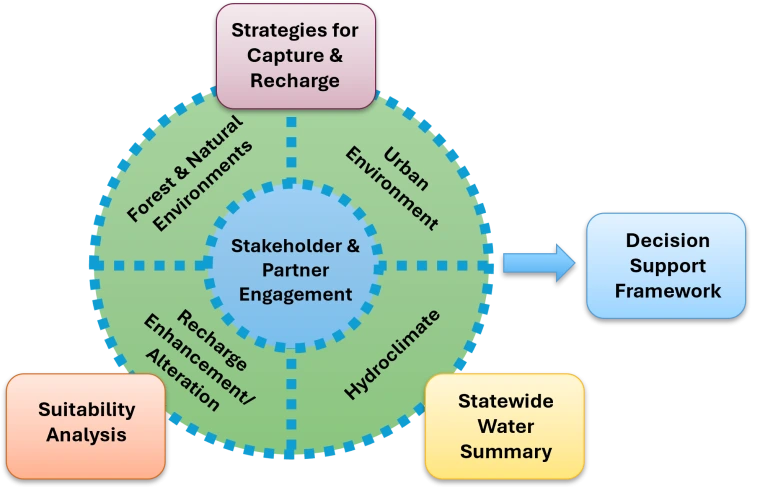Our ATUR Project Approach
Project Structure
The Arizona Tri-University Recharge and Water Reliability Project (ATUR) has 5 subteams comprised of researchers, post docs, and graduate students from the three state universities, the University of Arizona (U of A), Arizona State University (ASU), and Northern Arizona University (NAU):
- Forests and Natural Environments Subteam
- Urban Environments Subteam
- Hydroclimate Subteam
- Recharge Alteration/Enhancement Subteam
- Stakeholder and Partner Engagement Subteam
While focused on their individual topic areas, the researchers integrate data, methods, and products across subteams. The Hydroclimate team is evaluating both present and future water balances across the state to develop a statewide water summary. The Recharge team is identifying locations where geology and hydrology are suitable for recharge. The Landscape and Urban teams have identified interventions for enhancing capture and recharge in both natural landscapes and urban environments. The Engagement team is focused on team coordination, science communication, and the integration of stakeholder feedback into project deliverables to ensure usable science. Together, this work culminates in a framework for prioritizing potential recharge locations and methods.

Methods
Estimate current and projected future precipitation, evaporation, recharge, and surface water runoff across the state by integrating observations, remote sensing products, and hydrologic models.
The ATUR Hydroclimate team is mapping existing and projected future hydrologic fluxes in Arizona’s groundwater basins. To our knowledge, this is the first time this type of basin-scale analysis is being done at a statewide level. Historical hydrologic fluxes (1980-2020) have been mapped through the use of the National Oceanic and Atmospheric Administration’s (NOAA) National Water Model (NWM) and Noah land surface model with multiparameterization options (Noah-MP), which provide gridded outputs for precipitation, evapotranspiration, surface runoff, groundwater recharge and other variables statewide. Model outputs are evaluated against on-the-ground data (stream gages, eddy covariance flux towers, snow telemetry stations, etc.) where available. The Hydroclimate team is currently working on future projections of water balance components statewide using downscaled general circulation models of future climate.
In addition to climatic changes, urbanization has an impact on water available for capture through increased runoff. The Urban team is using the Environmental Protection Agency’s Integrated Climate and Land Use Scenarios (ICLUS) to model land use changes in the context of climate change and understand the potential for capturing increased stormwater from urbanization.
Map surface and subsurface geology to identify areas where water can readily recharge aquifers.
The Recharge team is examining surface and subsurface properties across the state to identify areas suitable for groundwater recharge. This includes the compilation of recharge suitability parameters including geologic and soil properties, land surface properties, land cover type, depth to water, etc., and combining these parameters with specific weighting criteria to provide an assessment of recharge potential across the state.
This geologic data is combined with the statewide summary of hydrologic components (hydroclimate data, baseflow indices, etc.) to identify the overlap of where there is water available for capture and where surface and subsurface properties are suitable for recharging that water. This suitability analysis tool is a flexible way to prioritize potential recharge sites.
Identify applicable strategies for capture and recharge for both urban and natural environments.
The Landscape and Urban teams are using a combination of empirical analyses, remote sensing, and publicly available models to investigate the impact of land management practices on the hydrologic cycle and enhancing recharge. Specifically, the Landscape team uses models including SnowPALM, ECOSTRESS, and Noah-MP along with empirical analyses and remote sensing to investigate the impact of forest thinning, wildfires, and stream channel management on hydrologic components (evapotranspiration, soil moisture, runoff, etc.) that affect recharge in natural areas. The Urban team employs both empirical analyses and models such as KINEROS2 and HYDRUS 1-D combined with machine learning to evaluate recharge strategies such as retention/detention basins and drywells in urban areas.
Engage and integrate feedback from stakeholders, including land and water management agencies, Indigenous communities, environmental research and policy groups, and agricultural groups through workshops and meetings.
The Engagement subteam coordinates and helps integrate the technical expertise of the other four ATUR subteams, translate scientific findings into accessible information for managers and practitioners, and incorporate feedback from stakeholders into technical analyses. The ADWR is regularly consulted for their feedback on project progress, approach and deliverables as the study’s principal client. Our Advisory Committee consists of 10 hydrologic experts from across the state’s land and water management agencies and hydrologic consulting firms. The Advisory Committee and two additional consultants provide technical expertise and guidance that inform the project technical approach, its applicability to ongoing water management, and our outreach and engagement efforts. In addition to ADWR and the Advisory Committee, four broad target groups were identified as having an important role in shaping the project deliverables given Arizona’s water management landscape: water and land management agencies, agricultural groups, environmental research and policy groups, and Indigenous communities. The primary goals for ATUR’s stakeholder engagement with these groups can be described as (1) consultation and information gathering, (2) study socialization within the Arizona water management community, (3) water management support, and (4) identification of potential project implementation partners for ADWR. Because of their traditional role as land and water managers and interest in engaging youth in STEM education, we have focused in particular on outreach with Tribes.
Integrate project findings into a prioritization framework to guide identification of locations for enhanced recharge projects and recommendations for capture and recharge interventions.
Efforts to identify the overlap of water availability and recharge suitability yield information to support criteria for selecting locations and methods for capturing water for recharge, such as minimum thresholds for precipitation (>500 mm) and soil properties that hinder recharge past the vadose zone (such as over 20% clay). These and other criteria will be incorporated into a decision support framework for ADWR and other natural resource managers to use in identifying areas suitable for interventions to promote enhanced recharge.

